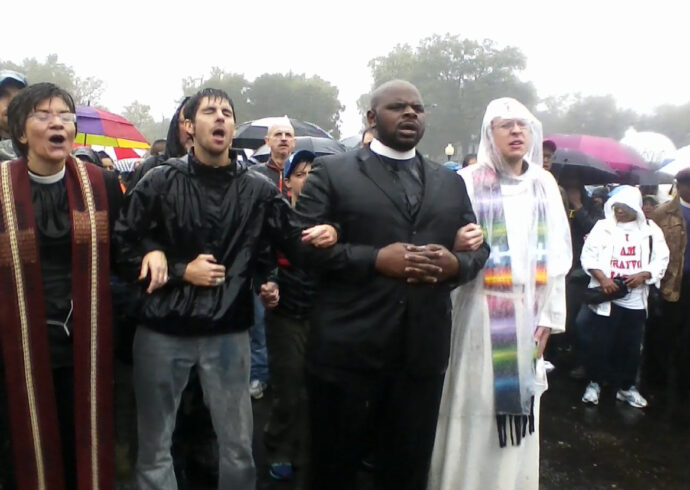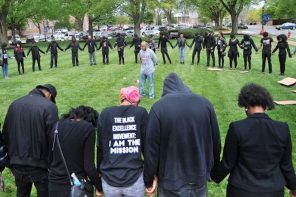Why are authorities responding to the protesters in Ferguson with tanks and tear gas, as if they are a threat to the American way of life?
Well, perhaps because they are.
I believe that the protests in Ferguson show the way forward for progressive religious activism—a true challenge to a broken system.
The civil rights movement of the 1960s drank deeply from religious wells. This energy was vital to the movement against racism because it was a claim to truth in the face of racism—that fundamental lie that runs through American history. In the Jim Crow era the false claim that some people matter more than others was proclaimed from every drinking fountain, voting booth, and restaurant counter.
Religious communities sustained the civil rights movement because they proclaimed a deeper truth that could not be undone by the lies of American culture. But the religious grounding of progressive social action has faltered since the 1960s.
In 1965, the Hart-Celler Act changed the rules concerning immigration. This legislation has altered the demographics of the United States and contributed to a more religiously diverse population. Then 1976, Christian televangelist Jerry Falwell organized “I Love America” rallies, a precursor to the founding of the Moral Majority in 1979. The Christian right declared that religion should shape politics, in two specific ways. First, they said America should be a Christian nation. Second, they implied that being Christian correlates to denigrating women, homosexuals, people of color, and peoples of other faiths. In this context, people who were struggling for justice found religious language difficult to employ outside of very localized contexts.
I came of age in an era when people with progressive politics avoided religious language altogether. There were some important exceptions, but many viewed Christian discourse in politics as a tactic of the right. Furthermore, those of us on the left honored America’s growing religious diversity and did not want to exclude people of different traditions. Progressive political action was cut off from the resource of religious conviction.
Over the years, I participated in a number of protests, marches, and demonstrations for various progressive causes, most notably to slow the rush to war. These events were either homogenous and religious, or diverse and non-religious. Either way, a major source of power was missing. We could not find a way to tap into both the power of our diversity and the power of our religious convictions.
We were left arguing on the basis of human rights or expediency or a vague notion of the common good. None of this has the power of the basic truth that 2+2 does, in fact, equal 4.
Ferguson is different. On August 19th, I received word that clergy were gathering to march with the protesters. We had two goals: to protest, and to accompany the black millennials who had been abused in the streets every night. When I arrived in Ferguson the next day, it made perfect sense that “clergy” included people from various religious traditions. Jews, Christians, Muslims—we were there together to say that black lives matter, to protect children on the streets. Each of us was compelled to the streets of Ferguson by deep convictions about religious truth. As a Christian, I was there because Michael Brown is a child of God and so are each of the protesters—it is not acceptable to kill children of God in the street. My fellow clergy might speak their own reasons quite differently, but we were there to proclaim truth together.
From those first days in August, pastors, rabbis, imams, and other religious people have been supporting the black millennial protesters who are central to this movement. People of faith have followed their own religious convictions into the streets to seek justice and demand change.
When I returned for another clergy march in October, I could not recognize all the various clerical garments. There were stoles and collars and kippot, but also other vestments that were unfamiliar to me. Our togetherness did not require assimilation into a single civic religion, or our polite downplaying of faith, or even a statement about how interreligious dialogue works. We just prayed. With our words, with our hearts, and with our feet.
Led by a group of black millennials, assisted by clergy of various faiths in the St. Louis area, supported by national faith-based organizing groups, something new is happening in Ferguson. This is an anti-racist movement that is diverse, diffuse, and democratic. It is also deeply religious. It is religious because people of faith are key to its operation and sustenance. It is religious because the protesters are participating in prayer and liturgy together to sustain their work (the recitation of a poem by Assata Shakur, for example). And it is religious because it is staking a truth claim about the value of black life that transcends the rhetoric and realities of American culture.
On October 13, I stood next to one of my students, David Wigger, facing a line of police in riot gear outside the Ferguson Police Department. One of the officers placed his hand on my student’s chest and shoved. As David stumbled backwards, I said to the officer, “Please don’t hurt him. He is my student.” The officer looked me in the eye and replied, “I didn’t touch him.”
David was unhurt, but I staggered at the bold-faced lie. It is a tiny instance of falsehood in a moment when we are swimming in a sea of deception and spin. Everywhere around us we are being told that 2+2=5. That peaceful protesters are criminals, that tanks are needed on suburban streets, that jaywalking is a capital offense. It is vital, in this context, to lay hold of truth that cannot be undone by media representation, by grand jury decisions, by legislation, or by indifference.
Last night, I knelt in front of cars with my hands up, shutting down a major intersection in Louisville, KY. A Jewish woman to my right, a Baptist woman to my left, a group of seminarians from Louisville Presbyterian Theological Seminary around us. I was one among many who participated in protests in 170 locations around the United States.
As the police gathered in numbers, as they ran towards us in the street, I felt an odd sense of hope. The ridiculously extreme response of authorities in Ferguson is an inverse measure of the potential of this movement. For people invested in white rule and racial disparity, the current protests are, indeed, a threat to the American way of life. But for many of us, these protests are the beginning of a new movement in the United States that reclaims the power of religion in the struggle for justice.



